
THE ALHAMBRA IN GRANADA
When I was in Granada many years ago, even then a visit to the Alhambra was a must. But I will gladly admit, that my memory mainly stored the impressions of the so-called "Palacios Nazaries". One of the most famous images is the "Patio de los Leones", in the palace of the same name, visible in the image on the right. After all, this is the part with the palaces, for which you have to pay admission.
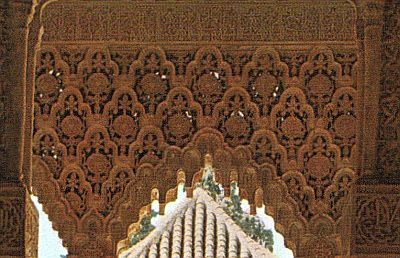
|
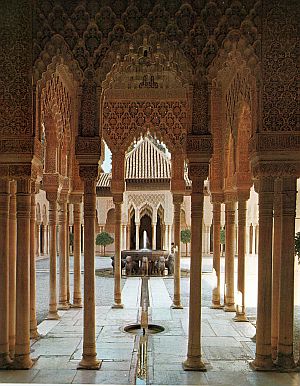 |
The rest of the Alhambra area can be visited for free. The palaces impress not only by their architecture, but also by the neatness of the decoration.
The Alhambra has 1.4 million visitors and is Spain's most visited tourist destination. This corresponds to just under 4,000 visitors a day, all year round. Therefore, it is perhaps not surprising that it was sold out a week ahead - and that in October!
But, as I said, the Alhambra is so much more. The entire area is 740 meters long and just over 200 wide. Below is a night view from Albaicin, the hill opposite Alhambra.
|

The name Alhambra is Arabic and means roughly "the Red Castle", whereby the red may refer to the color, which the walls assume at sunset.
The mountain, where the Alhambra stands, was populated long before the Romans got there. In the 8th century, the Muslim conquest of the peninsula took place, the southern part of which was basically dominated by the Caliphate of Cordoba until the 12th century, when the caliphate came to an end. Then a first fortress was built on the mountain, which was basically just "an Alcazaba", a citadel. In the 14th century, the Emir of Jaen, Muhammad ibn Yusuf ibn Nasr, moved his residence to Granada and extended the present-day Alhambra. Muhammad also founded his own dynasty, the Nasrids.
Then the Nasrids retained power until 1492, as the last Mohammedan outpost in Europe, when the Catholic kings, Isabella (Elisabeth) and Ferdinand, liberated the country in its entirety.
Thus also ended an epoch in the development of mankind, since the moors (dear child has many names) accounted for a huge percentage of scientific innovation in many areas.
|
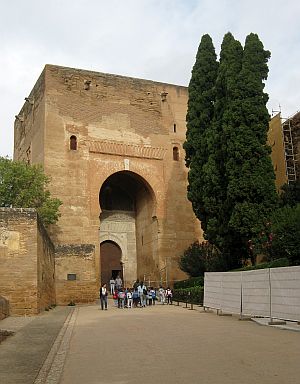
Puerta de la Justicia |
Instead, the Inquisition gained a foothold, which meant a persecution of Jews, the burning of Arabic books, people who were forced to profess Christianity, and more. The device for all this came into being within the Alhambra, the so-called Alhambra edict.
In the 16th century, when the Habsburg Emperor Charles V (in Spain Carlos I) inherited Spain, he ruled most of Europe, as well as the possessions of America. In doing so, he ruled a "kingdom, where the sun never set."
|
For a while he wanted to make Granada the capital of Spain, but changed his mind, when the riches from the other side of the Atlantic began to flow in. However, he had already started building his own palace in the Alhambra, Square on the outside, but round on the inside. The exterior of the Renaissance building is indeed very beautiful (some have called it the most beautiful outside of Italy), but it nevertheless contrasts strongly with the filigree work of the moors. The circular courtyard creates another strong contrast.
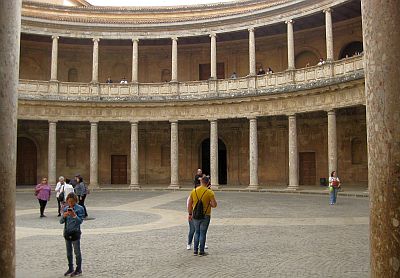
|
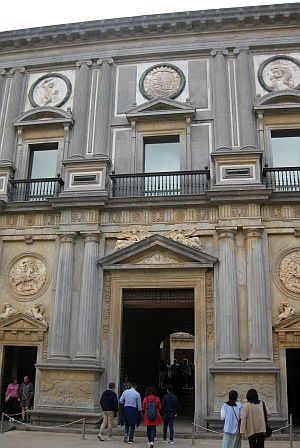 |
There are two museums in the palace. One is an archaeological museum, which only displays a huge number of finds that were made in the region. The bull in the picture on the right originates from about 600 - 400 BC and was found near Jaen.
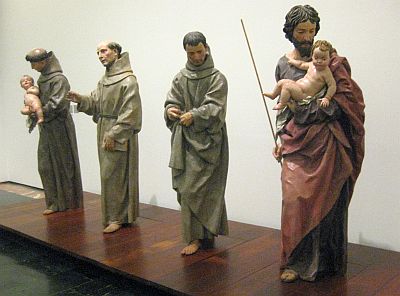
|
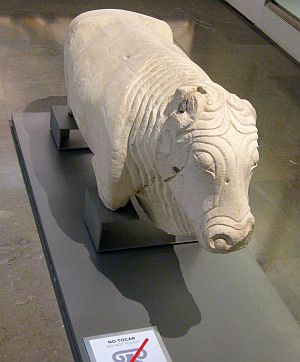 |
But the predominant part consists of Moorish, that is, Arabic art. This museum is highly recommended.
The second is a museum of Fine Arts, exhibiting a lot of paintings and sculptures with religious motifs. In the picture above, from the left, two apostles are visible - Anthony and Peter, a saint - Daniel of Alcala, as well as Joseph. The latter part of the exhibition concentrates on worldly motives.
Of course, there would be much more to say about these museums, but that would blow up the space for this page.
|
From almost everywhere - inside and outside the Alhambra area - you get a view towards the defensive walls of the Alcazaba, the Citadel (the photo on the right is taken from inside the palace of Carlos V). Logically, it also constitutes the highest part of the place.
A little further up is the Generalife, which served as a "summer cottage" for the Sultans. It is also a very beautiful building. However, it is not only a palace, but also consists of various garden facilities.
|
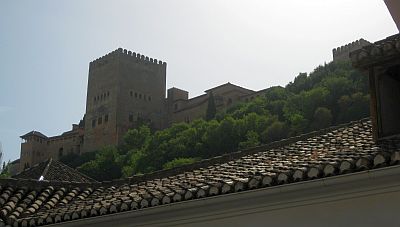 |
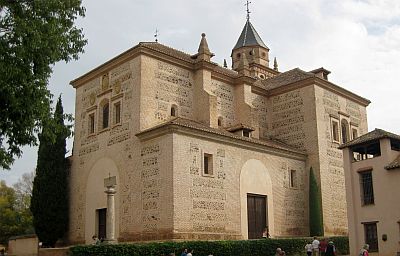
A little above the palace of Charles V, there is the Church of Santa Maria de la Alhambra, which was built on the ruins of a mosque. It was completed in the early 18th century and most of the art treasures in the church date from the time just before. In the picture on the right you can see the large main altar, which is dominated by a Pieta under a crucified Christ. The large statues of Santa Ursula and Santa Susana flank the central part.
|
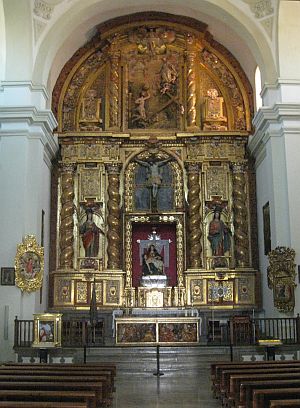 |
Before getting ready to head back to the city, we make a stop at the viewpoint towards Albaicin. The district is located opposite the Alhambra, on the other side of the Valley. It bribes with its consistently white buildings and is said to be the oldest district in Granada. Today, due to its location, opposite the Alhambra, it is a tourist destination and offers not least a multitude of restaurants.
Part of the Albaicin consists of Sacromonte, famous for its inhabited caves. Today it is a stronghold of flamenco shows.
|
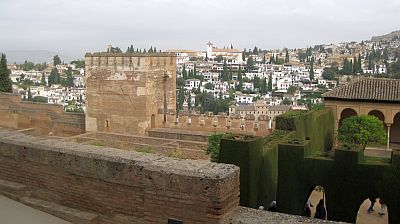 |
Via Puerta del Vino we crowd with all the other tourists and finally end up at the Puerta de la Justicia, where we entered the Alhambra. Outside we walk through the large forest areas belonging to the castle.
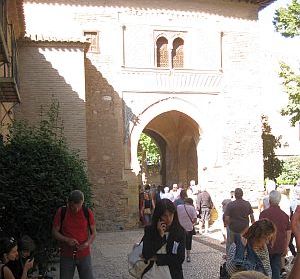 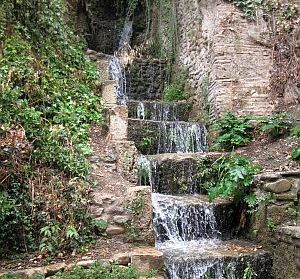 There are quite steep slopes, but it is much easier to go down than to climb up. Small waterfalls and gutters splash pleasantly, but the splash is swallowed up by the murmur all around. Soon we come across a statue of Irving Washington by the roadside. He is praised in this way, because at the beginning of the 19th century he lived here and wrote the book "Tales from the Alhambra".
There are quite steep slopes, but it is much easier to go down than to climb up. Small waterfalls and gutters splash pleasantly, but the splash is swallowed up by the murmur all around. Soon we come across a statue of Irving Washington by the roadside. He is praised in this way, because at the beginning of the 19th century he lived here and wrote the book "Tales from the Alhambra".
|
We continue on the way through the Alhambra Forest and finally end up at the"Puerta de las Granadas". It separates the Alhambra area from the rest of the city. It was erected in 1526 by order of Charles V, as a pendant to the other gates, leading up to his palace. The gate's name comes from the three open pomegranates on its top. In addition, in the tympanum of the gate there is the coat of arms of Charles V, characterized by the Double-Headed Eagle of the Habsburgs, which holds the shield itself, as well as the imperial crown on top of everything.
Copyright Bernhard Kauntz, Västerås 2022
|
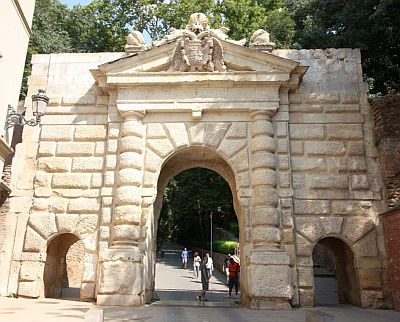 |
Back to  ,
or to the ,
or to the  of of 
page constructed on: 8.11.2022 by webmaster@werbeka.com
|



